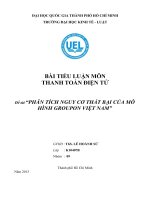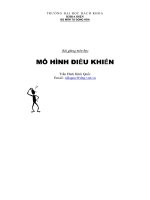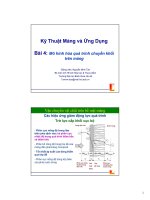Bài 6: Mô hình Random Utility
Bạn đang xem bản rút gọn của tài liệu. Xem và tải ngay bản đầy đủ của tài liệu tại đây (786.93 KB, 30 trang )
<span class='text_page_counter'>(1)</span><div class='page_container' data-page=1>
THEORY OF INDIVIDUAL CHOICE
AND APPLICATION:
THE RANDOM UTILITY MODEL
</div>
<span class='text_page_counter'>(2)</span><div class='page_container' data-page=2>
Development of RUM
Lancaster’s attribute based utility theory
The Law of Comparative Judgment (Thurstone 1927)
Individuals react to stimuli
When making choices among alternatives, individuals choose
the one with highest level of stimulus
Stimulus comprises an objective level and a random error
Economists interpret stimulus as utility (Marschak
1960, Manski1977)
systematic component
the random component
Individuals choose the alternative with the highest level
</div>
<span class='text_page_counter'>(3)</span><div class='page_container' data-page=3>
Development of RUM (cont)
The specification of random and systematic
utility
makes the model probabilistic
estimate the utility function
The model was made popular by McFadden
(1974)
multinomial logit (MNL) model
nested logit model
</div>
<span class='text_page_counter'>(4)</span><div class='page_container' data-page=4>
Application of RUM
Transportation demand: choice among
transportation modes
Environmental valuation:
choice data generated from real market (actual
choice, or Revealed Preference data)
choice data from hypothetical market (Stated
Preference data)
Experimental data that involves choice among
options
</div>
<span class='text_page_counter'>(5)</span><div class='page_container' data-page=5>
Utility function
Alternative specific constants
Error terms
The probabilistic choice
</div>
<span class='text_page_counter'>(6)</span><div class='page_container' data-page=6>
Structure of RUM
Alternatives
Alternative 1 Alternative 2
… Alternative J
1 1 1
</div>
<span class='text_page_counter'>(7)</span><div class='page_container' data-page=7>
The utility function
<i>Utility from alternative j include</i>
systematic component
the random component
j
<i>V</i>
j
j j j
</div>
<span class='text_page_counter'>(8)</span><div class='page_container' data-page=8>
The utility function
Utility from alternative j is assumed to be a
function of attributes of alternative j
utility of from alternative j
level of attribute k of alternative j
marginal utility of attribute k (to be estimated)
Note: is constant specific to alternative j
j 0 <i>j</i> 1 <i>j</i>1 1 <i>j</i>2 ... <i>K</i> <i>jK</i>
<i>V</i>
<i>x</i>
<i>x</i>
<i>x</i>j
<i>V</i>
<i>jk</i>
<i>x</i>
<i>k</i>
<i>0 j</i>
</div>
<span class='text_page_counter'>(9)</span><div class='page_container' data-page=9>
The alternative specific constant
(ASC)
The constant term of each alternative is ASC
The model is unidentifiable if all the ASCs are
estimated. We have to fix one of them at 0
1 1
<i>V</i> <i>X</i>
2 2 2
<i>V</i> <i>ASC</i> <i>X</i>
J
<i>J</i> <i>J</i>
<i>V</i> <i>ASC</i> <i>X</i>
...
<b>ASC reflects </b>
<b>the preference </b>
<b>on each </b>
</div>
<span class='text_page_counter'>(10)</span><div class='page_container' data-page=10>
The error term
Gumbel distributed random
variable
location parameter
scale parameter
,
<i>G</i>
:
<i>e</i>
<i>F</i>
<i>e</i>
0
<i>e</i>
<i>f</i>
<i>e</i>
<i>e</i>
</div>
<span class='text_page_counter'>(11)</span><div class='page_container' data-page=11>
The error term
Properties of the Gumbel distribution
1. Mode ; Mean where
(Euler’s constant); and variance
2. If then
3. If and then
is logistically distributed
<sub></sub>
<sub></sub>
<sub>0.577</sub>
2
2
6
,
<i>G</i>
:
<i>V</i>
:
<i>G</i>
<i>V</i>
,
1
<i>G</i>
1,
:
<sub>2</sub>:
<i>G</i>
<sub>2</sub>,
*
1 2
<sub></sub>
*<sub></sub>
2 1
*
1
1
<i>F</i>
<i>e</i>
</div>
<span class='text_page_counter'>(12)</span><div class='page_container' data-page=12>
The error term
Properties of the Gumbel distribution
4. If ; ; …;
are independent, then
1 <i>G</i> 1,
: <sub>2</sub> : <i>G</i>
<sub>2</sub>,
<sub>,</sub>
<i>J</i> <i>G</i> <i>J</i>
:
1 2
1
1
max
,
,...,
ln
<i>j</i>,
<i>J</i>
<i>J</i>
<i>j</i>
<i>G</i>
<i>e</i>
</div>
<span class='text_page_counter'>(13)</span><div class='page_container' data-page=13>
The probability of choosing
alternative
The utility function
The probability of choosing j
<i>j</i> <i>j</i> <i>j</i>
<i>U</i> <i>V</i>
Pr j is chosen among C
<i>j</i>
<i>p</i>
Pr U , , j,l
<i>j</i> <i>j</i> <i>l</i>
<i>p</i> <i>U</i> <i>l</i> <i>j</i> <i>C</i>
*
Pr U max Pr U
<i>j</i> <i>j</i> <i>l</i> <i>j</i>
<i>l C</i> <i>j</i>
<i>p</i> <i>U</i> <i>U</i>
<sub></sub> <sub></sub>
* *
* *
Pr V + Pr V
<i>j</i> <i>j</i> <i>j</i> <i>j</i> <i>j</i>
<i>p</i> <i>V</i> <i>V</i>
*
1
1 <i>j</i>
<i>j</i> <i><sub>V</sub></i> <i><sub>V</sub></i>
<i>p</i>
<i>e</i>
</div>
<span class='text_page_counter'>(14)</span><div class='page_container' data-page=14>
The probability of choosing
alternative
Properties of the Gumbel distribution result in
1
<i>j</i>
<i>l</i>
<i>V</i>
<i>j</i> <i><sub>J</sub></i>
<i>V</i>
<i>l</i>
<i>e</i>
<i>p</i>
<i>e</i>
</div>
<span class='text_page_counter'>(15)</span><div class='page_container' data-page=15>
Estimation of the RUM
Log-likelihood
the choice of individual i on alternative j (1 =
chosen)
Coefficients of the utility functions are estimated by
maximizing the log-likelihood function
1
<i>j</i>
<i>l</i>
<i>V</i>
<i>j</i> <i>J</i>
<i>V</i>
<i>l</i>
<i>e</i>
<i>p</i>
<i>e</i>
1 1
log ln
<i>N</i> <i>J</i>
<i>ij</i> <i>ij</i>
<i>i</i> <i>j</i>
<i>L</i> <i>Y</i> <i>p</i>
<i>ij</i>
</div>
<span class='text_page_counter'>(16)</span><div class='page_container' data-page=16>
Method of estimation
Data: Revealed preference and Stated preference
Data organization
</div>
<span class='text_page_counter'>(17)</span><div class='page_container' data-page=17>
Estimation of the RUM model
Assume location and scale
Likelihood function
Log-likelihood function
The model is estimated
by maximizing the log-likelihood function
0
1
1
<i>j</i>
<i>l</i>
<i>V</i>
<i>j</i> <i>J</i>
<i>V</i>
<i>l</i>
<i>e</i>
<i>p</i>
<i>e</i>
1 1
<i>ij</i>
<i>N</i> <i>J</i> <i><sub>Y</sub></i>
<i>ij</i>
<i>i</i> <i>j</i>
<i>L</i> <i>p</i>
1 1
log ln
<i>N</i> <i>J</i>
<i>ij</i> <i>ij</i>
<i>i</i> <i>j</i>
<i>L</i> <i>Y</i> <i>p</i>
is actual observed choice,
= 1 if j is chosen,
= 0 otherwise
<i>ij</i>
</div>
<span class='text_page_counter'>(18)</span><div class='page_container' data-page=18>
Data for RUM – Stated preference
Choices are obtained in a hypothetical situation
respondents are presented with a set of alternatives
each alternative are characterized by a set of
attributes’ levels
respondents are asked to choose among the
presented alternatives
</div>
<span class='text_page_counter'>(19)</span><div class='page_container' data-page=19>
Stated preference data – Example 1
Harper (2012) estimates WTP for the
conservation of endangered species (caribou)
Respondents were asked to choose between 2
alt
status quo: current management strategy
the proposed management strategy
</div>
<span class='text_page_counter'>(20)</span><div class='page_container' data-page=20></div>
<span class='text_page_counter'>(21)</span><div class='page_container' data-page=21>
Organization of RUM data
<b>Resp</b> <b>Choice </b>
<b>set</b> <b>Alt</b> <b>Herd</b> <b>Cost</b> <b>Choice</b>
</div>
<span class='text_page_counter'>(22)</span><div class='page_container' data-page=22>
Stated preference data – Example 2
Pham and Tran (2005) used choice modelling to
analyze the demand for water service improvement
Each respondent were asked to make several
choices between:
the current situation (status quo)
the improved service plan
Each alternative is characterized by 3 attributes:
water quality (with 3 levels: low, medium, high)
water pressure (low; medium; high)
</div>
<span class='text_page_counter'>(23)</span><div class='page_container' data-page=23></div>
<span class='text_page_counter'>(24)</span><div class='page_container' data-page=24>
Organization of RUM data
<b>Resp</b> <b>Choice </b>
<b>set</b> <b>Alt</b> <b>qualityWater</b> <b>pressureWater </b> <b>Cost</b> <b>Choice</b>
</div>
<span class='text_page_counter'>(25)</span><div class='page_container' data-page=25>
Coding of qualitative variables
2 levels: water quality (2 discrete levels Low and
High)
create a dummy variable WQ
WQ = 1 if high quality; 0 otherwise
How to interpret the estimated coefficient of WQ?
3 levels (or more): water pressure (Low, Medium
and High
2 dummy variables PM and PH
PM = 1 if medium; 0 otherwise
PH = 1 if high; 0 otherwise
Similar for the case of more than 3 levels
</div>
<span class='text_page_counter'>(26)</span><div class='page_container' data-page=26>
What RUM can do?
Probability of choosing
Demand analysis
Predict the changes in
probability
quantity demanded
when an attribute changes.
1
<i>j</i>
<i>l</i>
<i>V</i>
<i>j</i> <i>J</i>
<i>V</i>
<i>l</i>
<i>e</i>
<i>p</i>
<i>e</i>
</div>
<span class='text_page_counter'>(27)</span><div class='page_container' data-page=27>
What RUM can do?
Estimate welfare changes resulted from a change
in attributes
is the attribute under consideration, p is the price
increases by 1 unit
p increases by 1 unit ($)
1 unit increase in is equivalent to ($)
increase in price
1
<i>V</i>
<i>x</i>
<i>p</i>
1
<i>x</i>
1
<i>x</i> <i>U</i>
<i>U</i>
1
<i>x</i>
</div>
<span class='text_page_counter'>(28)</span><div class='page_container' data-page=28>
Collect data
Input and organize data
Estimate the RUM using Stata
Calculate the probability of choosing a product
Illustration of how to calculate log-likelihood
value
</div>
<span class='text_page_counter'>(29)</span><div class='page_container' data-page=29>
Example: demand for chocolate bar
A producer considers introducing a new product (chocolate
bar) to the market
The producer found that the following attributes are important
weight (gr): 50, 100, 200
type: milk or dark
ingredient: with or without nuts
price (1000 VND): 15, 30, 45
Target market
Questions:
How to decide the levels of attributes?
</div>
<span class='text_page_counter'>(30)</span><div class='page_container' data-page=30>
Sample questionnaire
Design #: 1
You are requested to consider a chocolate bar with the characteristics presented below
Chocolate bar
Weight (gram) <b><sub>50 </sub></b>
Type (milk chocolate or dark chocolate) <b><sub>Dark </sub></b>
Ingredients (With nuts or not) <b><sub>No nuts </sub></b>
Price (thousand VND) <b><sub>15 </sub></b>
Would you buy the chocolate bar? □ Yes □ No
Please let us know:
Your gender □ Male □ Female
</div>
<!--links-->









